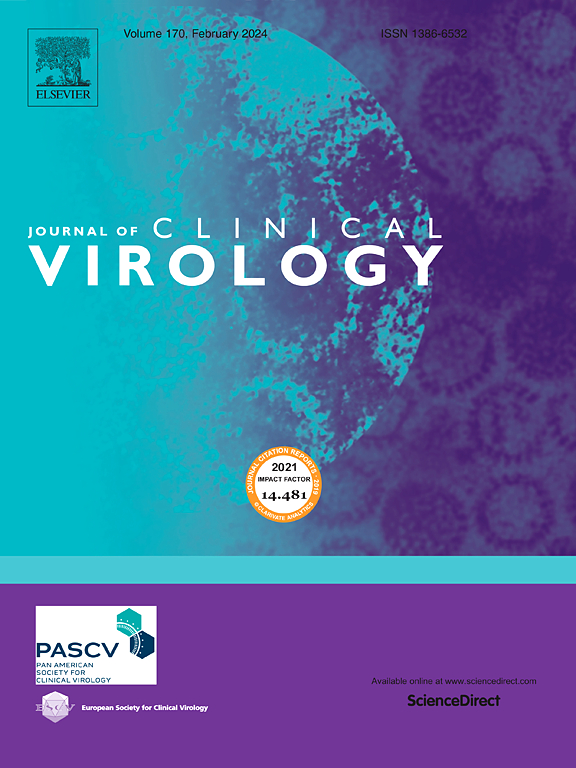求医急性呼吸道疾病学龄儿童鼻病毒流行病学及基因型多样性
IF 3.4
3区 医学
Q2 VIROLOGY
引用次数: 0
摘要
背景:鼻病毒(RV)相关的急性呼吸道疾病(ARI)数据主要来自婴幼儿。方法在2016年12月1日至2017年11月30日期间,美国新疫苗监测网络(NVSN)的7个站点使用分子平台检测多种呼吸道病原体,对住院患者(IP)和急诊科(ED)患者进行了儿科ARI监测。对未合并检测的RV或RV/ EV阳性标本进行测序。通过父母访谈和图表回顾收集的人口统计学和临床数据按RV品种、月份和医院设置进行描述性分析,使用卡方检验进行比较。结果2298例急性呼吸道感染患者中有581例(25.3%)检出RV或RV/EV;529例为单次检测,其中516例具有足够的测序样本,420例(81.4%)获得测序结果:RV- a(183例,35.5%)、RV- b(16例,3.1%)、RV- c(210例,40.7%)、不可分型RV(2例,0.4%)和EV(9例,1.7%)。在鉴定出的52株RV-A、8株RV-B和44株RV-C中,以A49(32, 61.5%)、B6(5, 62.5%)和C15(22, 50%)为主。65.4%的RV-A、50%的RV-B和78.5%的RV-C患者有哮喘病史(p = 0.005)。RV-A患者住院率为63.4%,RV-B患者为37.5%,RV-C患者为71.4% (p = 0.012)。RV-C检测在冬季达到高峰,RV-A检测在夏秋季达到高峰。结论5 ~ 17岁ARI患者srv具有遗传多样性,不同RV种类的循环存在差异。在急诊科或医院就诊的儿童中,确诊RV或RV/EV单一检测,RV- a和-C比RV- b更常见。本文章由计算机程序翻译,如有差异,请以英文原文为准。
Epidemiology and genotypic diversity of rhinovirus in school-age children with acute respiratory illnesses seeking medical care
Background
Rhinovirus (RV) associated acute respiratory illness (ARI) data come mostly from infants and young children. We present data from 5 to 17-year-olds to characterize RV species A, B and C.
Methods
During December 1, 2016–Nov 30, 2017, seven U.S. New Vaccine Surveillance Network (NVSN) sites performed active pediatric ARI surveillance of inpatients (IP) and emergency department (ED) patients using molecular platforms to detect multiple respiratory pathogens. RV or RV/enterovirus (EV) positive specimens without co-detections were sequenced. Demographic and clinical data collected via parent interview and chart review were analyzed descriptively by RV species, month, and hospital setting, using chi-squared tests for comparisons.
Results
RV or RV/EV was detected in 581/2298 (25.3 %) ARI patients; 529 were single detections, 516 of these had sufficient sample for sequencing, and 420 (81.4 %) yielded sequence results: RV-A (183, 35.5 %), RV-B (16, 3.1 %), RV-C (210, 40.7 %), non-typeable RV (2, 0.4 %), and EV (9, 1.7 %). Among 52 RV-A, 8 RV-B and 44 RV-C unique types identified, A49 (32, 61.5 %), B6 (5, 62.5 %) and C15 (22, 50 %) were predominant. History of asthma was reported in 65.4 % RV-A, 50 % RV-B and 78.5 % RV-C patients (p = 0.005). Hospitalization occurred in 63.4 % RV-A, 37.5 % RV-B and 71.4 % RV-C patients (p = 0.012). RV-C detections peaked during winter and RV-A peaked during summer-fall.
Conclusions
RV exhibited genetic diversity in 5–17-year-old ARI patients, and circulation differed by RV species. Among children seeking care in ED or hospital settings, with confirmed RV or RV/EV single detections, hospitalization was more common with RV-A and -C than RV-B.
求助全文
通过发布文献求助,成功后即可免费获取论文全文。
去求助
来源期刊

Journal of Clinical Virology
医学-病毒学
CiteScore
22.70
自引率
1.10%
发文量
149
审稿时长
24 days
期刊介绍:
The Journal of Clinical Virology, an esteemed international publication, serves as the official journal for both the Pan American Society for Clinical Virology and The European Society for Clinical Virology. Dedicated to advancing the understanding of human virology in clinical settings, the Journal of Clinical Virology focuses on disseminating research papers and reviews pertaining to the clinical aspects of virology. Its scope encompasses articles discussing diagnostic methodologies and virus-induced clinical conditions, with an emphasis on practicality and relevance to clinical practice.
The journal publishes on topics that include:
• new diagnostic technologies
• nucleic acid amplification and serologic testing
• targeted and metagenomic next-generation sequencing
• emerging pandemic viral threats
• respiratory viruses
• transplant viruses
• chronic viral infections
• cancer-associated viruses
• gastrointestinal viruses
• central nervous system viruses
• one health (excludes animal health)
 求助内容:
求助内容: 应助结果提醒方式:
应助结果提醒方式:


